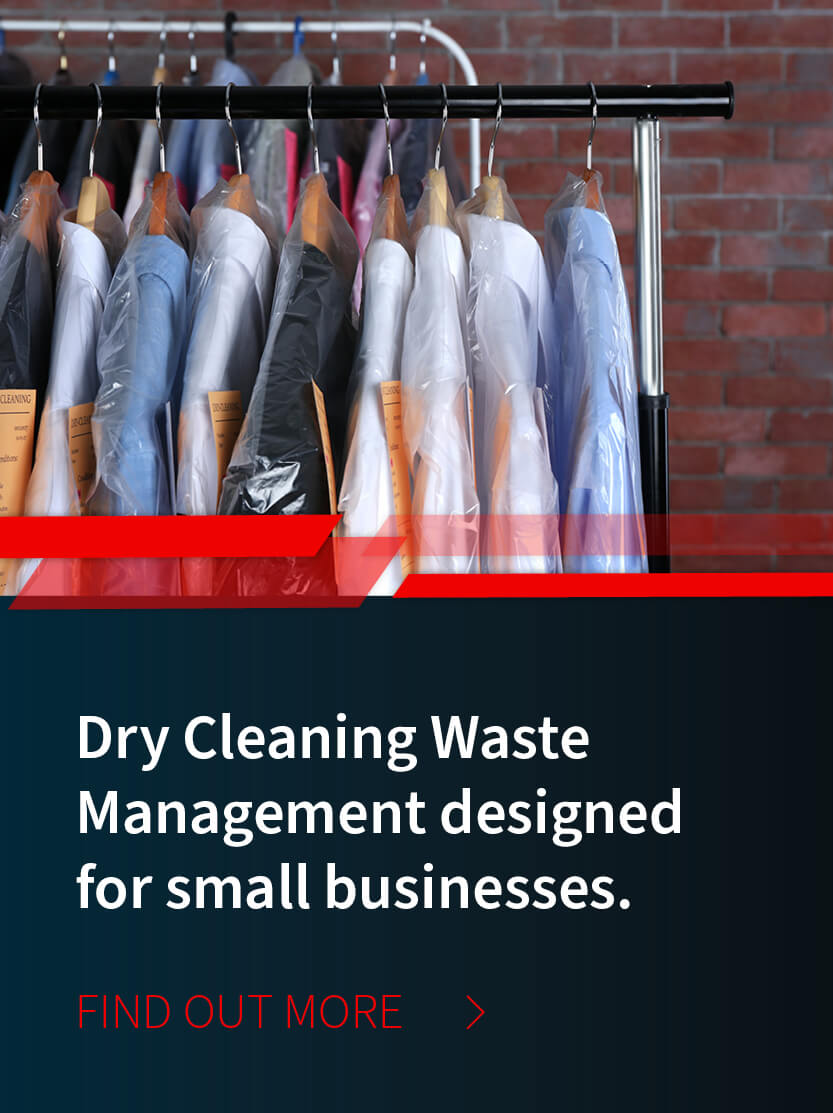
/ IN THIS BLOG
01 / Hazardous chemicals & wastes from dry cleaning
Modern dry cleaning processes generate a variety of wastes that require hazardous waste management.
First, there are the raw chemicals to consider. Among them:
Tetrachloroethylene is a colorless liquid that’s widely used for dry cleaning, so much so that it’s commonly called “dry cleaning fluid.” The International Agency for Research on Cancer has classified it as a Group 2A carcinogen.
Perchloroethylene (aka perc) is a solvent that’s highly useful in dry cleaning operations for its ability to dissolve grease, oil, and wax from textiles without damaging them. But it’s also a reproductive toxicant, neurotoxicant, potential carcinogen, and persistent environmental pollutant. Any water that has come into direct contact with perc is a listed hazardous waste, and even very small amounts of it can significantly pollute soil and groundwater. (Water contaminated with perc cannot be discharged into private septic systems or public sewers.) Thereby, as of December 2020, the EPA has banned the use of perc in dry cleaning businesses that share space inside residential buildings.
Petroleum Distillates like Exxon 2000 are a combustible liquid material developed as a safer and more environmentally sustainable alternative to solvents like perc. These petroleum distillates are less effective overall than perc, but also are less damaging to the environment and though they are still combustible, provide a safer alternative when used correctly. As states like California move to ban perc, petroleum distillates are an increasingly popular choice for dry cleaners, used by about one in three MCF dry cleaning customers.
Second, there are the residues, metals, sludges, and water that get removed during the afore-mentioned filtration and distillation phases of dry cleaning.
Virtually all of these substances require hazardous waste disposal, and they pose a particular challenge for businesses that dry clean shop, printer, paint, or mechanics’ rags or uniforms.
02 / How is dry cleaning waste hazardous?
Dry cleaning waste can be hazardous in just about every way cited by the EPA. Remember,
there are two kinds of hazardous waste according to the EPA: listed and characteristic.
Listed wastes. The EPA maintains two lists of substances that it considers hazardous waste, called the “P” and “U” lists. (Hence, “listed wastes.”) The main difference between the two is their level of risk. Stated succinctly, U-listed wastes are “toxic” and P-listed ones are worse.
Characteristic wastes. Wastes that don’t appear on the U or P lists might nonetheless require hazardous waste management due to their “characteristics.” (Hence, “characteristic wastes.”) There are four characteristics: ignitability, corrosively, toxicity, and reactivity.
03 / What size hazardous waste generator are you?
The size of your dry cleaning business likely correlates to the hazardous waste generator status you’re considered to be by the EPA.
Once you’ve determined that you’re generating hazardous wastes, you must determine your generator status and comply with the hazardous waste regulations applicable to that status.
Per the EPA:
You’re a Large Quantity Generator (LQG) if you generate 2,200 lbs. or more of hazardous waste per month
A Small Quantity Generator (SQG) if you produce more than 220 but less than 2,200 lbs. per month
A Very Small Quantity Generator (VSQG) if you generate 220 lbs. or less of hazardous per month
04 / The upshot
MCF Environmental Services has become one of America’s most respected hazardous waste disposal companies, trusted to handle the byproduct chemicals and hazardous materials that are integral to the industry.
Over the course of 30-plus years serving dry cleaning companies of all sizes, we’re dedicated to helping our clients overcome the unique challenges posed by federal, state, and local environmental regulations pertinent to their operations.
Beyond managing the collection and disposal of dry cleaning hazardous materials, we will partner with you to help identify the kinds of wastes you’re generating, provide guidance about how to segregate those wastes into hazardous vs. non-hazardous streams, and advise you about the best hazardous waste management storage and accumulation practices.
For more information, contact us today. Or phone 866.315.8116
And thank you for reading our blog!
Robert Losurdo
President, COO








